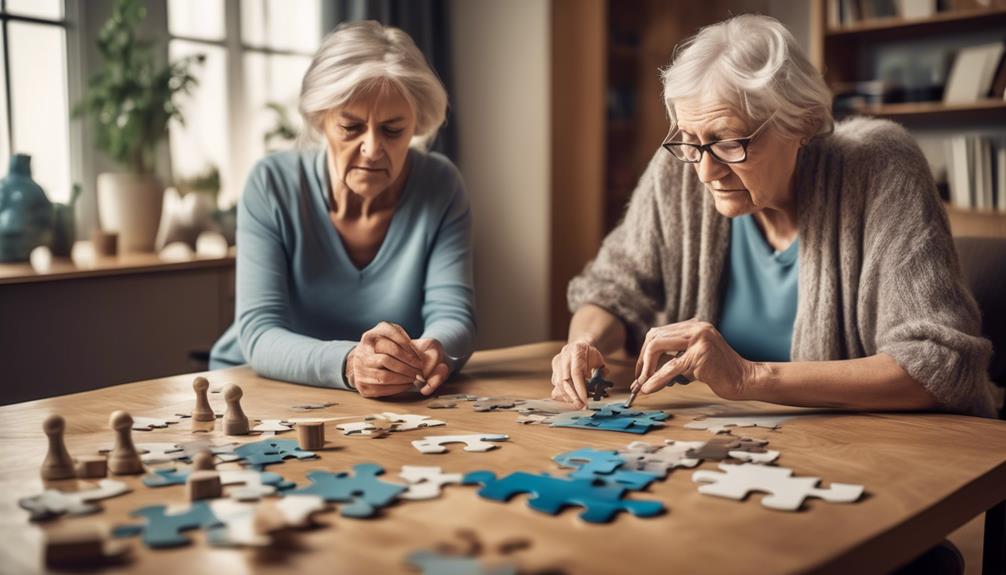Studying the intricate link between depression and dementia is essential to improving our comprehension of cognitive health.
As we navigate the complexities of these conditions, a deeper understanding of their intertwined nature emerges, shedding light on potential avenues for intervention and support.
In unraveling the mysteries that bind depression and dementia, we unearth a wealth of insights that could revolutionize how we approach mental well-being and aging.
Key Takeaways
- Depression increases the risk of developing dementia throughout life.
- Severity and duration of depression play a significant role in dementia risk.
- Shared mechanisms include vascular disease, glucocorticoid alterations, and hippocampal atrophy.
- Treatment approaches include a combination of pharmacological and non-pharmacological interventions.
Risk Factors for Depression and Dementia
When considering the risk factors for depression and dementia, it becomes evident that depression is a common factor throughout life that significantly increases the likelihood of developing dementia. Studies have shown that earlier-life depression is linked to a two-fold or greater increase in the risk of dementia, while late-life depression is associated with a two to five-fold increased risk. Furthermore, the presence of additional depressive symptoms further escalates the risk of developing dementia.
Interestingly, some studies have indicated that the association between late-life depression and dementia may be present only in specific subgroups, showcasing the complexity of this relationship. Various potential mechanisms such as vascular disease, alterations in glucocorticoid steroids, hippocampal atrophy, β-amyloid plaque formation, and inflammatory changes are believed to play a role in linking depression and dementia.
It is crucial to understand that having a prior diagnosis of depression significantly heightens the chances of developing dementia. Age and gender don't seem to influence the connection between depression and dementia, emphasizing the universality of this association. Multiple hospitalizations for depression can also elevate the risk of dementia, underlining the importance of early intervention in mental health.
While being prescribed antidepressants shortly after a depression diagnosis doesn't seem to impact the rate of dementia diagnosis, the exact mechanism linking depression and dementia remains a subject of ongoing research efforts.
Impact of Depression on Dementia Progression

Understanding the impact of depression on dementia progression is crucial for comprehending the complexities of these interconnected conditions. Depression is a common condition that has been found to increase the risk of developing dementia later in life. Both early-life and late-life depression are associated with an increased risk of dementia, with the severity and duration of depression playing a significant role in influencing this risk. Certain populations, such as men or individuals with specific genetic factors, may have a higher risk of developing dementia associated with depression. Multiple potential mechanisms, including vascular disease and changes in brain structure, link depression and dementia. The risk of dementia is notably higher in individuals previously diagnosed with depression, emphasizing the importance of recognizing and addressing depressive symptoms to potentially slow down dementia progression. Here is a table summarizing the impact of depression on dementia progression:
| Key Points | Details |
|---|---|
| Increased Risk of Dementia | Depression is linked to a 2.41 times higher risk of developing dementia. |
| Treatment of Depressive Symptoms | Addressing depression may help in potentially slowing down the progression of dementia. |
| Individuals with Depressive Symptoms | Those with depressive symptoms should be monitored closely for dementia development. |
Shared Mechanisms Between Depression and Dementia
Shared biological mechanisms between depression and dementia underscore the intricate relationship between these two conditions, highlighting the interconnectedness of their pathophysiology. Understanding these shared mechanisms can provide valuable insights into the complex nature of depression and dementia.
Here are four key points to consider:
- Depression, especially earlier-life and late-life depression, is linked to a higher risk of developing dementia, establishing a bidirectional relationship between the two conditions.
- Vascular disease, alterations in glucocorticoid steroids, hippocampal atrophy, and increased deposition of β-amyloid plaques serve as potential mechanisms connecting depression and dementia.
- The cortisol-hippocampal pathway and amyloid plaque formation contribute significantly to the association between depression and dementia, indicating overlapping pathways in their pathogenesis.
- Inflammation, oxidative stress, hypothalamic-pituitary-adrenal (HPA) axis dysregulation, neurodegenerative processes like hippocampal atrophy and amyloid-beta accumulation, as well as vascular factors, play crucial roles in the shared mechanisms between depression and dementia. Psychological and social factors, such as cognitive reserve and social isolation, also influence this complex relationship.
Treatment Approaches for Coexisting Depression and Dementia

Exploring effective treatment strategies for individuals grappling with both depression and dementia presents a critical aspect in addressing the intricate interplay between these complex conditions.
When treating coexisting depression and dementia, a combination of pharmacological and non-pharmacological interventions is often necessary. Antidepressant medications may be prescribed to alleviate symptoms of depression in individuals with dementia, although they may be less effective for those with Alzheimer's disease.
Non-pharmacological approaches such as cognitive-behavioral therapy and psychosocial interventions can also be beneficial. Lifestyle modifications, including staying active, engaging socially, and reducing stress, play a crucial role in managing these conditions.
Regular monitoring and adjustment of treatment plans are vital to address the unique needs and challenges of patients with both depression and dementia. Seeking care from healthcare professionals specializing in these areas is recommended for proper evaluation and treatment.
Caregiver support and education are essential components of managing coexisting depression and dementia, emphasizing the importance of a comprehensive and personalized approach to care.
Supporting Individuals With Both Conditions
Supporting individuals simultaneously dealing with depression and dementia requires a comprehensive and personalized approach that addresses their unique needs and challenges. When supporting individuals with both conditions, it's crucial to consider the following:
- Recognize the increased risk for dementia in individuals with a history of depression. Regular screenings and early intervention can play a vital role in managing both conditions effectively.
- Understand that antidepressant medication may not always be the most effective treatment for depression in individuals with Alzheimer's disease. Exploring alternative therapies and lifestyle modifications can be beneficial.
- Emphasize the importance of social engagement, physical activity, and stress reduction in managing both depression and dementia. Encouraging a supportive environment can significantly improve the quality of life for individuals facing these challenges.
- Seek specialized care from healthcare professionals experienced in treating dementia and depression. Their expertise can provide proper evaluation, personalized treatment plans, and ongoing support for individuals navigating both conditions.
Frequently Asked Questions
What Is the Link Between Dementia and Depression?
When exploring the link between dementia and depression, we find a strong association where individuals previously diagnosed with depression are 2.41 times more likely to develop dementia.
This connection remains consistent across age and gender.
The severity of late-life depression and the presence of additional symptoms can further increase the risk of dementia.
Understanding these connections is crucial for early detection and effective intervention strategies to promote overall brain health.
What Is the Most Pronounced Symptom of Depression With Dementia Suffers?
The most pronounced symptom of depression in individuals with dementia is a persistent feeling of sadness or hopelessness. It can be challenging to navigate through these emotions, but seeking support and understanding can make a significant difference.
Our loved one, for example, experienced a loss of interest in activities they once enjoyed, which was a clear sign of their struggle. By recognizing and addressing this symptom, we were able to provide them with the care and attention they needed.
Is Depression a Precursor to Alzheimer's?
Yes, depression can be a precursor to Alzheimer's. Research shows individuals with a previous depression diagnosis are 2.41 times more likely to develop dementia. Factors like age, gender, and antidepressant use don't alter this connection.
Understanding this link is crucial for early intervention. More studies are needed to uncover the biological and behavioral aspects of this relationship for better care strategies.
Do Antidepressants Help Prevent Dementia?
We understand the desire to find ways to prevent dementia, and the question of whether antidepressants can help is a common one. While antidepressants have many benefits, research suggests they may not be effective in preventing dementia.
It's essential to explore various strategies, including lifestyle changes and specialized care, to manage depression and dementia effectively. By staying informed and seeking expert guidance, we can navigate these complex conditions with compassion and understanding.
Conclusion
As we navigate the complex landscape of depression and dementia, it's essential to recognize the interconnectedness of these conditions. By understanding the shared risk factors and mechanisms, we can better support individuals facing both challenges.
Through comprehensive treatment approaches and compassionate care, we can strive to improve quality of life and promote overall well-being. Let's continue to advocate for holistic approaches that address the unique needs of those affected by depression and dementia, fostering hope and resilience in the face of adversity.









